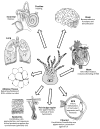What are melanocytes really doing all day long...?
- PMID: 19659579
- PMCID: PMC2792575
- DOI: 10.1111/j.1600-0625.2009.00912.x
What are melanocytes really doing all day long...?
Erratum in
- Exp Dermatol. 2009 Dec;18(12):1096
Abstract
Everyone knows and seems to agree that melanocytes are there to generate melanin - an intriguing, but underestimated multipurpose molecule that is capable of doing far more than providing pigment and UV protection to skin (1). What about the cell that generates melanin, then? Is this dendritic, neural crest-derived cell still serving useful (or even important) functions when no-one looks at the pigmentation of our skin and its appendages and when there is essentially no UV exposure? In other words, what do epidermal and hair follicle melanocytes do in their spare time - at night, under your bedcover? How much of the full portfolio of physiological melanocyte functions in mammalian skin has really been elucidated already? Does the presence or absence of melanocytes matter for normal epidermal and/or hair follicle functions (beyond pigmentation and UV protection), and for skin immune responses? Do melanocytes even deserve as much credit for UV protection as conventional wisdom attributes to them? In which interactions do these promiscuous cells engage with their immediate epithelial environment and who is controlling whom? What lessons might be distilled from looking at lower vertebrate melanophores and at extracutaneous melanocytes in the endeavour to reveal the 'secret identity' of melanocytes? The current Controversies feature explores these far too infrequently posed, biologically and clinically important questions. Complementing a companion viewpoint essay on malignant melanocytes (2), this critical re-examination of melanocyte biology provides a cornucopia of old, but under-appreciated concepts and novel ideas on the slowly emerging complexity of physiological melanocyte functions, and delineates important, thought-provoking questions that remain to be definitively answered by future research.
Figures

References
-
- Yamaguchi Y, Brenner M, Hearing VJ. The regulation of skin pigmentation. J Biol Chem. 2007;282:27557–27561. - PubMed
-
- Tolleson WH. Human melanocyte biology, toxicology, and pathology. J Environ Sci and Health. 2005;23:105–161. - PubMed
-
- Montagna W, Carlisle K. The architecture of black and white facial skin. J Am Acad Dermatol. 1991;24:929–937. - PubMed
-
- Spritz RA. Molecular genetics of oculocutaneous albinism. Hum Mol Genet. 1994;3:1469–1475. - PubMed
-
- King RA, Hearing VJ, Creel DJ, Oetting WS. Albinism. In: Scriver CR, Beaudet AL, Sly WS, Valle D, editors. The metabolic and molecular bases of inherited disease. New York: McGraw-Hill; 2001. pp. 5587–5627.
Publication types
MeSH terms
Substances
Grants and funding
LinkOut - more resources
Full Text Sources
Other Literature Sources

